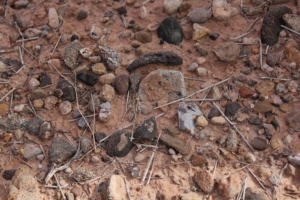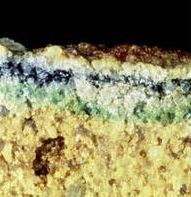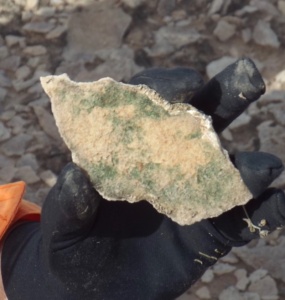Science Post – October 21st
Imprinting of Life in the “Barren” Rocks: Endoliths and Chasmoliths
By Crew Biologist Anushree Srivastava
It is mesmerizing to observe photosynthetic life thriving beautifully inside the rocks while at the first glance they seem to be lifeless. It requires the eyes of an explorer and will of an adventurer to keep roaming around on the land studded with the variety of rocks and find those which host green hardy friends. After my previous short note on the hypoliths in a broader sense and after scouting the widespread cross-bedded sandstone during today’s extra-vehicular activity, I am compelled to write about endoliths and chasmoliths. Fundamentally, endoliths are organisms living inside the porous rocks, mostly sandstone, and chasmoliths live within the cracks and crevices. Sedimentary rocks particularly provide the optimal conditions to endoliths to colonize few millimeters beneath the surface where sunlight penetrates enough to facilitate photosynthesis but protects them from harsh radiation. Steve Pointing and co-workers described these rock dwellers in the Antarctic dry valleys in their 2009 paper and found endoliths as composite communities of bacteria and eukaryotes including lichens, green alga and ultraviolet-resistant cyanobacteria at different depths in different layers. In the same way, chasmoliths in the fractures and voids are composed of different bacterial groups, lichens, and cynabacteria. Together they have been found to consist of 50 bacterial species. These organisms are particular of interest to astrobiogists and proposed to be potential target for extraterrestrial exploration of microbial life, considering their hardy nature and subsurface establishments. For the MARS 160 science mission, Crew Geologist Dr Jonathan Clarke, HSO Annalea Beattie, who is being cross-trained in the hypoliths , and I intend to study these “lithobionts” from the geo-astro-biological perspective in the analog environment of MDRS.

Figure 1. Field study of hypoliths. Credit: Crew Journalist Anastasia Stepanova
Figure 2. Endoliths. Credit: NASA and taken from How Stuff Works- Life
in the Extreme website.
Figure 3. Chamoliths. Credit: Crew Geologist Jon Clarke, and HSO
Annalea Beattie.
`
Further Reading:
Pointing SB, Chan Y, Lacap DC, Lau MC, Jurgens JA, & Farrell RL (2009)
Highly specialized microbial diversity in hyper-arid polar desert.
Proceedings of the National Academy of Sciences of the United States
of America, 106 (47), 19964-9





